François Rottenberg
Leveraging Power Amplifier Distortion for Physical Layer Security
Jul 10, 2025Abstract:This paper introduces a new approach to physical layer security (PLS) by leveraging power amplifier (PA) nonlinear distortion through distortion-aware precoding. While some conventional PLS techniques inject artificial noise orthogonal to legitimate channels, we demonstrate that inherent PA nonlinearities typically considered undesirable can be exploited to enhance security. The zero 3rd order (Z3RO) precoder applies a negative polarity to several antennas to cancel the PA distortion at the user location, resulting in distortion being transmitted in non-user locations. Redirecting the distortion to non-user locations creates interference for potential eavesdroppers, lowering their signal-to-noise-and-distortion ratio (SNDR). Numerical simulations reveal that the Z3RO precoder achieves up to a $2.5\times$ improvement in secrecy rate compared to conventional maximum ratio transmission (MRT) precoding under a $10\%$ outage probability, SNR of $32$ dB and $-5$ dB input back-off (IBO) where the PAs enter the saturation regime.
On Optimizing Time-, Space- and Power-Domain Energy-Saving Techniques for Sub-6 GHz Base Stations
May 21, 2025Abstract:What is the optimal base station (BS) resource allocation strategy given a measurement-based power consumption model and a fixed target user rate? Rush-to-sleep in time, rush-to-mute in space, awake-but-whisper in power, or a combination of them? We propose in this paper an efficient solution to the problem of finding the optimal number of active time slots, active antennas, and transmit power at active antennas in a multiple-input multiple-output (MIMO) orthogonal frequency-division multiplexing (OFDM) system under per-user rate and per-antenna transmit power constraints. The use of a parametric power consumption model validated on operator measurements of 4G and 5G BSs enhances the interpretation of the results. We discuss the optimal energy-saving strategy at different network loads for three BS configurations. Using as few BS antennas as possible is close to optimal in BSs not implementing time-domain power savings such as micro-discontinuous transmission ({\mu}DTX). Energy-saving schemes that jointly operate in the three domains are instead optimal when the BS hardware can enter time-domain power-saving modes, with a tendency for rush-to-mute in massive MIMO and for rush-to-sleep in BS with fewer antennas. Median energy savings up to $30\%$ are achieved at low network loads.
GNN-based Precoder Design and Fine-tuning for Cell-free Massive MIMO with Real-world CSI
May 13, 2025Abstract:Cell-free massive MIMO (CF-mMIMO) has emerged as a promising paradigm for delivering uniformly high-quality coverage in future wireless networks. To address the inherent challenges of precoding in such distributed systems, recent studies have explored the use of graph neural network (GNN)-based methods, using their powerful representation capabilities. However, these approaches have predominantly been trained and validated on synthetic datasets, leaving their generalizability to real-world propagation environments largely unverified. In this work, we initially pre-train the GNN using simulated channel state information (CSI) data, which incorporates standard propagation models and small-scale Rayleigh fading. Subsequently, we finetune the model on real-world CSI measurements collected from a physical testbed equipped with distributed access points (APs). To balance the retention of pre-trained features with adaptation to real-world conditions, we adopt a layer-freezing strategy during fine-tuning, wherein several GNN layers are frozen and only the later layers remain trainable. Numerical results demonstrate that the fine-tuned GNN significantly outperforms the pre-trained model, achieving an approximate 8.2 bits per channel use gain at 20 dB signal-to-noise ratio (SNR), corresponding to a 15.7 % improvement. These findings highlight the critical role of transfer learning and underscore the potential of GNN-based precoding techniques to effectively generalize from synthetic to real-world wireless environments.
How to Perform Distributed Precoding to Wirelessly Power Shelf Labels: Signal Processing and Measurements
Aug 20, 2024Abstract:Wireless power transfer (WPT) has garnered increasing attention due to its potential to eliminate device-side batteries. With the advent of (distributed) multiple-input multiple-output (MIMO), radio frequency (RF) WPT has become feasible over extended distances. This study focuses on optimizing the energy delivery to Energy Receivers (ERs) while minimizing system total transmit power. Rather than continuous power delivery, we optimize the precoding weights within specified time slots to meet the energy requirements of the ERs. Both unsynchronized (non-coherent) and synchronized (coherent) systems are evaluated. Our analysis indicates that augmenting the number of antennas and transitioning from an unsynchronized to asynchronized full phase-coherent system substantially enhances system performance. This optimization ensures precise energy delivery, reducing overshoots and overall energy consumption. Experimental validation was conducted using a testbed with84 antennas, validating the trends observed in our numerical simulations.
Enhancing RSS-Based Visible Light Positioning by Optimal Calibrating the LED Tilt and Gain
Apr 29, 2024
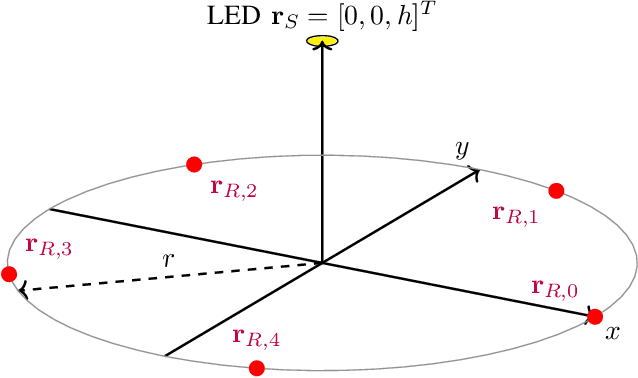
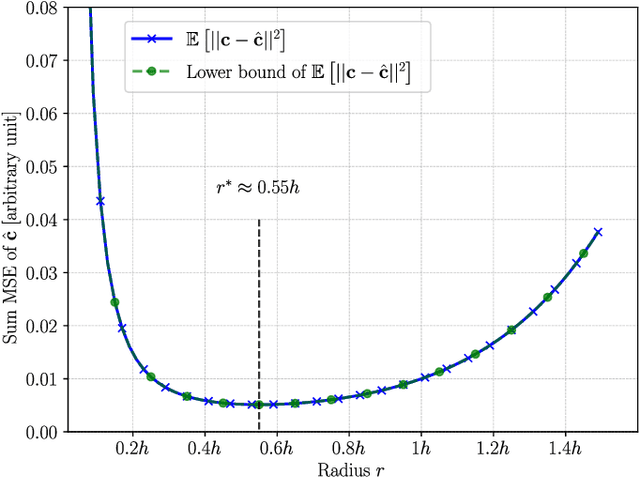

Abstract:This paper presents an optimal calibration scheme and a weighted least squares (LS) localization algorithm for received signal strength (RSS) based visible light positioning (VLP) systems, focusing on the often overlooked impact of light emitting diode (LED) tilt. By optimally calibrating LED tilt and gain, we significantly enhance VLP localization accuracy. Our algorithm outperforms both machine learning Gaussian processes (GPs) and traditional multilateration techniques. Against GPs, it achieves improvements of 58% and 74% in the 50th and 99th percentiles, respectively. When compared to multilateration, it reduces the 50th percentile error from 7.4 cm to 3.2 cm and the 99th percentile error from 25.7 cm to 11 cm. We introduce a low-complexity estimator for tilt and gain that meets the Cramer-Rao lower bound (CRLB) for the mean squared error (MSE), emphasizing its precision and efficiency. Further, we elaborate on optimal calibration measurement placement and refine the observation model to include residual calibration errors, thereby improving localization performance. The weighted LS algorithm's effectiveness is validated through simulations and real-world data, consistently outperforming GPs and multilateration, across various training set sizes and reducing outlier errors. Our findings underscore the critical role of LED tilt calibration in advancing VLP system accuracy and contribute to a more precise model for indoor positioning technologies.
Optimal Training Design for Over-the-Air Polynomial Power Amplifier Model Estimation
Apr 19, 2024Abstract:The current evolution towards a massive number of antennas and a large variety of transceiver architectures forces to revisit the conventional techniques used to improve the fundamental power amplifier (PA) linearity-efficiency trade-off. Most of the digital linearization techniques rely on PA measurements using a dedicated feedback receiver. However, in modern systems with large amount of RF chains and high carrier frequency, dedicated receiver per RF chain is costly and complex to implement. This issue can be addressed by measuring PAs over the air, but in that case, this extra signalling is sharing resources with the actual data transmission. In this paper, we look at the problem from an estimation theory point of view so as to minimize pilot overhead while optimizing estimation performance. We show that conventional results in the mathematical statistics community can be used. We find the least squares (LS) optimal training design, minimizing the maximal mean squared error (MSE) of the reconstructed PA response over its whole input range. As compared to uniform training, simulations demonstrate a factor 10 reduction of the maximal MSE for a L = 7 PA polynomial order. Using prior information, the LMMSE estimator can achieve an additional gain of a factor up to 300 at low signal-to-noise ratio (SNR).
Toward Energy-Efficient Massive MIMO: Graph Neural Network Precoding for Mitigating Non-Linear PA Distortion
Dec 05, 2023Abstract:Massive MIMO systems are typically designed assuming linear power amplifiers (PAs). However, PAs are most energy efficient close to saturation, where non-linear distortion arises. For conventional precoders, this distortion can coherently combine at user locations, limiting performance. We propose a graph neural network (GNN) to learn a mapping between channel and precoding matrices, which maximizes the sum rate affected by non-linear distortion, using a high-order polynomial PA model. In the distortion-limited regime, this GNN-based precoder outperforms zero forcing (ZF), ZF plus digital pre-distortion (DPD) and the distortion-aware beamforming (DAB) precoder from the state-of-the-art. At an input back-off of -3 dB the proposed precoder compared to ZF increases the sum rate by 8.60 and 8.84 bits/channel use for two and four users respectively. Radiation patterns show that these gains are achieved by transmitting the non-linear distortion in non-user directions. In the four user-case, for a fixed sum rate, the total consumed power (PA and processing) of the GNN precoder is 3.24 and 1.44 times lower compared to ZF and ZF plus DPD respectively. A complexity analysis shows six orders of magnitude reduction compared to DAB precoding. This opens perspectives to operate PAs closer to saturation, which drastically increases their energy efficiency.
Energy-Saving Cell-Free Massive MIMO Precoders with a Per-AP Wideband Kronecker Channel Model
Sep 27, 2023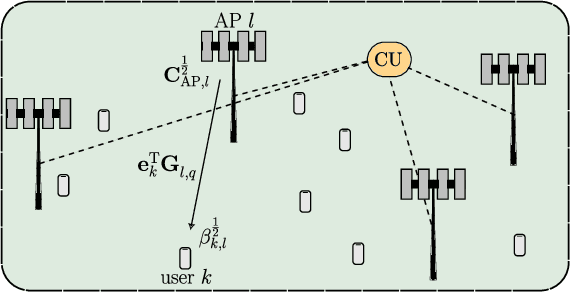

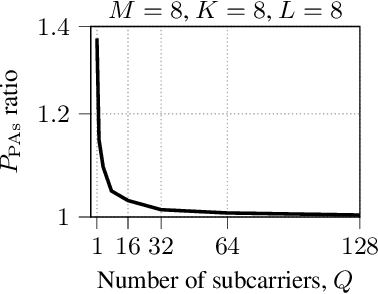
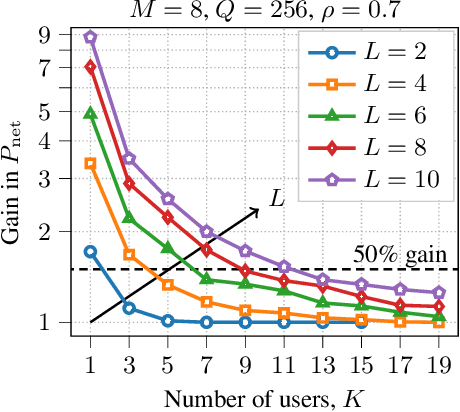
Abstract:We study cell-free massive multiple-input multiple-output precoders that minimize the power consumed by the power amplifiers subject to per-user per-subcarrier rate constraints. The power at each antenna is generally retrieved by solving a fixed-point equation that depends on the instantaneous channel coefficients. Using random matrix theory, we retrieve each antenna power as the solution to a fixed-point equation that depends only on the second-order statistics of the channel. Numerical simulations prove the accuracy of our asymptotic approximation and show how a subset of access points should be turned off to save power consumption, while all the antennas of the active access points are utilized with uniform power across them. This mechanism allows to save consumed power up to a factor of 9$\times$ in low-load scenarios.
Deep Unfolding for Fast Linear Massive MIMO Precoders under a PA Consumption Model
Apr 25, 2023Abstract:Massive multiple-input multiple-output (MIMO) precoders are typically designed by minimizing the transmit power subject to a quality-of-service (QoS) constraint. However, current sustainability goals incentivize more energy-efficient solutions and thus it is of paramount importance to minimize the consumed power directly. Minimizing the consumed power of the power amplifier (PA), one of the most consuming components, gives rise to a convex, non-differentiable optimization problem, which has been solved in the past using conventional convex solvers. Additionally, this problem can be solved using a proximal gradient descent (PGD) algorithm, which suffers from slow convergence. In this work, to overcome the slow convergence, a deep unfolded version of the algorithm is proposed, which can achieve close-to-optimal solutions in only 20 iterations compared to the 3500 plus iterations needed by the PGD algorithm. Results indicate that the deep unfolding algorithm is three orders of magnitude faster than a conventional convex solver and four orders of magnitude faster than the PGD.
Energy-Saving Precoder Design for Narrowband and Wideband Massive MIMO
Apr 04, 2023Abstract:In this work, we study massive multiple-input multiple-output (MIMO) precoders optimizing power consumption while achieving the users' rate requirements. We first characterize analytically the solutions for narrowband and wideband systems minimizing the power amplifiers (PAs) consumption in low system load, where the per-antenna power constraints are not binding. After, we focus on the asymptotic wideband regime. The power consumed by the whole base station (BS) and the high-load scenario are then also investigated. We obtain simple solutions, and the optimal strategy in the asymptotic case reduces to finding the optimal number of active antennas, relying on known precoders among the active antennas. Numerical results show that large savings in power consumption are achievable in the narrowband system by employing antenna selection, while all antennas need to be activated in the wideband system when considering only the PAs consumption, and this implies lower savings. When considering the overall BS power consumption and a large number of subcarriers, we show that significant savings are achievable in the low-load regime by using a subset of the BS antennas. While optimization based on transmit power pushes to activate all antennas, optimization based on consumed power activates a number of antennas proportional to the load.
 Add to Chrome
Add to Chrome Add to Firefox
Add to Firefox Add to Edge
Add to Edge